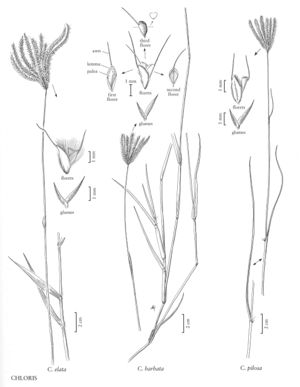Chloris pilosa
Plants annual or short-lived perennials; sometimes shortly stoloniferous. Culms 30-70(200) cm, erect or somewhat decumbent. Sheaths glabrous or sparsely to densely pilose; blades to 30 cm long, 2-10 mm wide, with coarse hairs behind the ligule and on the lower portion of the margins. Panicles digitate, with 5-9 clearly distinct or easily separable branches; branches 3-5 cm, with 5-7 spikelets per cm. Spikelets barely imbricate, pale to dark gray, often mottled when mature, with 1 bisexual and (1)2 sterile florets. Lower glumes 1.1-1.6 mm; upper glumes 1.9-2.3 mm, awned, awns to 0.3 mm; lowest lemmas 2.3-3.5 mm, broadly ovate or elliptic, keels gibbous, sides with a conspicuous glabrous or pubescent groove, margins glabrous or appressed pubescent, apices awned, awns to 6 mm; second florets 1.5-2.2 mm, widened and inflated distally, mucronate or awned, awns to 3 mm; distal florets less than 1 mm, turbinate; anthers 0.4-0.5 mm. Caryopses 1.3-1.5 mm long, 0.5-0.6 mm wide, trigonous. 2n = 20, 30.
Discussion
Chloris pilosa is native to equatorial Africa, but it is sometimes planted for forage. It has been collected in Kleberg County, Texas, possibly from an experimental forage planting; it is not known to be established in the Flora region.
Selected References
None.
